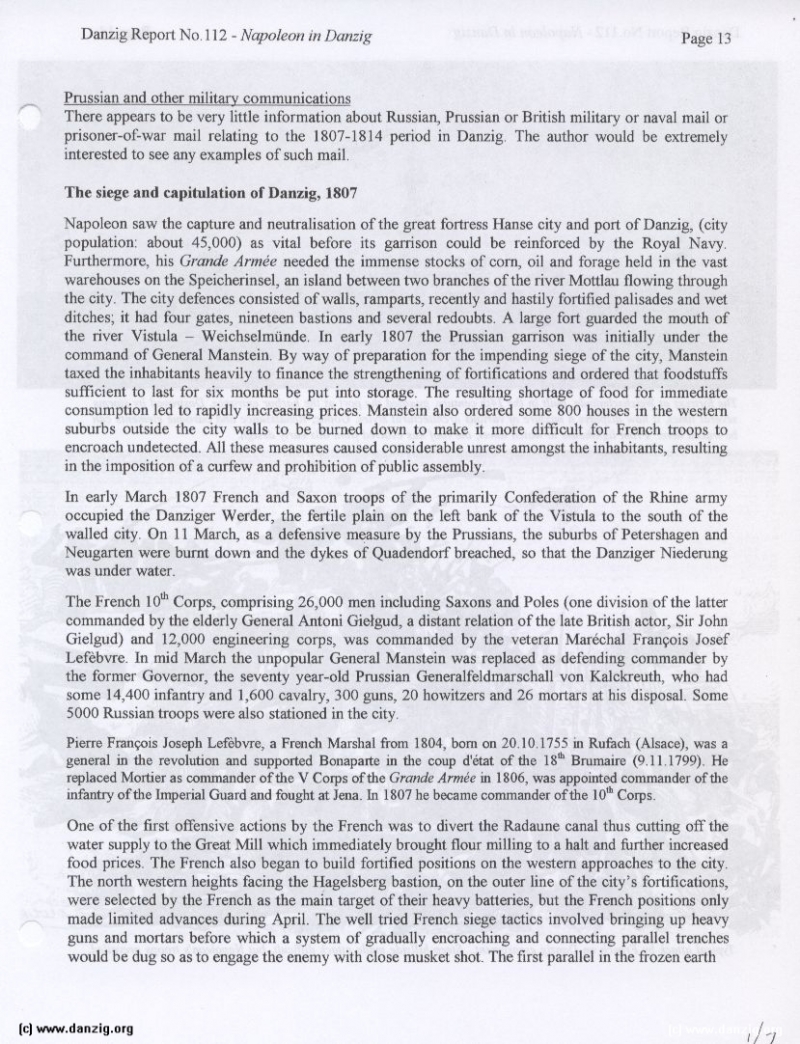
Prussian other military communications
There appears to be very little information about Russian, Prussian or British military or naval mail or prisoner-of-war mail relating to the 1807-1814 period in Danzig. The author would be extremely interested to see any examples of such mail
The siege and capitulation of Danzig, 1807
Napoleon saw the capture and neutralisation of the great fortress Ilanse city and port of Danzig, (city population about 45,000) as vital before its garrison could be reinforced by the Royal Navy. Furthermore, his Grande Armée needed the immense stocks of corn, oil and forage held in the vast warehouses on the Speicherinsel, an island between two branches of the river Mottlau flowing through the city. The city defences consisted of walls, ramparts, recently and hastily fortified palisades and wet ditches; it had four gates, nineteen bastions and several redoubts. A large fort guarded the mouth of the river Vistula — WcichselmUnde, In early 1807 the Prussian garrison was initially under the command of General Manstein, By way of preparation for the impending siege of the city, Manstein taxed the inhabitants heavily to finance the strengthening of fortifications and ordered that foodstuffs sufficient to last for six months be put into storage. The resulting shortage of food for immediate consumption led to rapidly increasing prices Manstein also ordered some 800 houses in the western suburbs outside the city walls to be burned down to make it more difficult for French troops to encroach undetected. All these measures caused considerable unrest amongst the inhabitants, resulting in the imposition of a curfew and prohibition of public assembly.
In early March 1807 French and Saxon troops of the primarily Confederation of the Rhine army occupied the Danziger Werder, the fertile plain on the left bank of the Vistula to the south of the walled city On 11 March, as a defensive measure by the Prussians, the suburbs of Petershagen and Neugartcn were burnt down and the dykes of Quadendorf breached, so that the Danziger Niederung was under water.
The French 10th Corps, comprising 26,000 men including Saxons and Poles (one division of the latter commanded by the elderly General Antoni Gielgud, a distant relation of the late British actor, Sir John Gielgud) and 12,000 engineering corps, was commanded by the veteran Maréchal François Josef Lefêbvre. In mid March the unpopular General Manstein was replaced as defending commander by the former Governor, the seventy year-old Prussian Generalfeldmarschall von Kalckreuth, who had some 14,400 infantry and 1,600 cavalry, 300 guns, 20 howitzers and 26 mortars at his disposal. Some 5000 Russian troops were also stationed in the city.
Pierre François Joseph Lefebvre, a French Marshal from 1804, born on 20.10.1755 in Rufach (Alsace), was a general in the revolution and supported Bonaparte in the coup d’etat of the 18’ Brumaire (9.11 1799). He replaced Mottler as commander of the V Corps of the Grandc Arméc in 1806. was appointod commander of the infantry of the Imperial Guard and fought at Jena. In 1807 he became commander of the 10’ Corps
One of the first offensive actions by the French was to divert the Radaune canal thus cutting off the water supply to the Great Mill which immediately brought flour milling to a halt and further increased food prices The French also began to build fortified positions on the western approaches to the city. The north western heights facing the Hagelsberg bastion, on the outer line of the city’s fortifications, were selected by the French as the main target of their heavy batteries, but the French positions only made limited advances during April. The well tried French siege tactics involved bringing up heavy guns and mortars before which a system of gradually encroaching and connecting parallel trenches would be dug so as to engage the enemy with close musket shot. The first parallel in the frozen earth
Danzig Report Vol. 1 - Nr. 112 - July - August - September - 2001, Page 13.
Hits: 3347
Added: 30/07/2015
Copyright: 2025 Danzig.org

